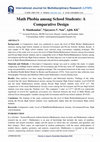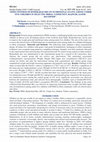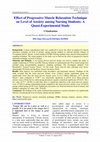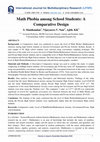Papers by Mr. S MANIKANDAN

International Journal of Science and Healthcare Research
Background: The safe and effective management of biomedical waste generated in the hospital is a ... more Background: The safe and effective management of biomedical waste generated in the hospital is a collective responsibility of all health workers involved in patient care. It is cardinal that the staff nurses must have up to date knowledge regarding handling and management of biomedical waste for the sake of both themselves and the patients. The aim of the study was to assess the knowledge, attitude and practice levels among staff nurses regarding biomedical waste management and to determine the relationship between knowledge, attitude and practice levels. Materials and Methods: The following study adopted a Correlational design. 100 staff nurses from selected hospitals in Kollam, Kerala were assigned using convenience sampling. The data was collected using a structured knowledge questionnaire, a five-point Likert attitude scale and a verbal response checklist. Results: Findings of the study revealed that the Spearman’s Rank Coefficient (Rho) ‘ρ’ calculated at 0.65** for finding the ...

International Journal For Multidisciplinary Research
Background: A Comparative study was conducted to assess the level of Math Phobia (Mathematical An... more Background: A Comparative study was conducted to assess the level of Math Phobia (Mathematical Anxiety) among high School students in selected Government and Private Schools, Kollam, Kerala. A total sample of 60, High school students were selected using convenience sampling technique. The objectives of the study were to assess the level of Math Phobia/Mathematical Anxiety among Government and Private High School students and to compare the level of Math Phobia/Mathematical Anxiety among Government and Private High School students. The final objective was to find out the association between level of Math Phobia/Mathematical Anxiety and selected Socio-demographic variables. Materials and Methods: A Descriptive Comparative design was used to conduct the study. A sample comprising of 60 High School students (30 Government and 30 Private) from 10th Standard were enrolled using non-probability convenience sampling technique. The conceptual framework of the study was based on Modified Heal...

International Journal of Science and Healthcare Research, 2023
Background: The safe and effective management of biomedical waste generated in the hospital is a ... more Background: The safe and effective management of biomedical waste generated in the hospital is a collective responsibility of all health workers involved in patient care. It is cardinal that the staff nurses must have up to date knowledge regarding handling and management of biomedical waste for the sake of both themselves and the patients. The aim of the study was to assess the knowledge, attitude and practice levels among staff nurses regarding biomedical waste management and to determine the relationship between knowledge, attitude and practice levels. Materials and Methods: The following study adopted a Correlational design. 100 staff nurses from selected hospitals in Kollam, Kerala were assigned using convenience sampling. The data was collected using a structured knowledge questionnaire, a five-point Likert attitude scale and a verbal response checklist. Results: Findings of the study revealed that the Spearman's Rank Coefficient (Rho) 'ρ' calculated at 0.65** for finding the relationship between knowledge and attitude levels was statistically significant at P<0.01 level. Also, the 'ρ' value (0.59**) calculated between knowledge and practice levels was significant at 0.01 level. The Chi square (χ2) value calculated was statistically significant for Knowledge level and selected sociodemographic variables such as; Gender (χ 2 18.56**, df=02, P<0.01 level) and Professional Experience (χ 2 11.59*, df-04, p<0.05 level); Also, between professional experience and Attitude (6.44**) and professional experience and practice levels (10.17**). The Fisher's exact test revealed association between Gender and Attitude (P# 0.016*, df=02, P<0.05 level) as well as Gender and Practice (P# 0.005**, df-01, P<0.01 level of significance). Conclusion: The findings confirmed that there was a medium/moderate positive correlation between knowledge and attitude as well as knowledge and practice levels regarding biomedical waste management among staff nurses.

International Journal of Research Publication and Reviews, 2023
Background: A Cross-sectional study was conducted to assess the level of Depression, Anxiety and ... more Background: A Cross-sectional study was conducted to assess the level of Depression, Anxiety and Stress experienced among Nursing students in selected Nursing College(s), Kollam district, Kerala. The objectives of the study were to assess the level of Depression, Anxiety and Stress among Nursing students and to compare the level of Depression, Anxiety and Stress among first year, second year, third year and final year B.Sc. Nursing students. The final objective was to find out the association between level of Depression, Anxiety and Stress among Nursing students with selected Socio-demographic variables. Materials and Methods: The study adopted a Descriptive-Cross-sectional design. 320 B.Sc. Nursing students from selected Nursing Colleges were enrolled using Proportionate Stratified-Random Sampling, technique. The conceptual framework of the study was based on Rosenstock and Becker’s Heath Belief Model, 1974. Tools used for data collection were Socio-Demographic Questionnaire and Modified Depression, Anxiety and Stress scale. [DASS-21]. Results: Findings of the study revealed that the Mean Depression score among final year B.Sc. Nursing students was higher [5.73±2.60] as compared to the first year, second year and third-year B.Sc. Nursing students. ANOVA [F test value 14.77**, (df=03, 316)] calculated was significant at 0.01 level. Also, the Mean Anxiety score [6.18±1.99] as well as the stress score [11.36±3.04] was found to be higher among the final year students, statistically significant at 0.01level. The first year BSc. Nursing students presented with the lowest Mean Depression [2.95±2.90], Anxiety [4.40±2.26] and Stress scores [8.21±3.67] on comparison with other student groups. Significant association was observed between the level of Depression and demographic variables such as Gender, Type of family and Area of residence. (p<0.01). Significant association was observed between level of Anxiety and Gender, Type of family, Type of stay and Education loan (p<0.01). Also, association was observed between level of Stress and Gender(p<0.05), Type of family(P<0.01). Conclusion: The findings of the study confirmed that the level of Depression, Anxiety and Stress scores were significantly higher among the Final year B.Sc. Nursing students than others.
Key Words: Cross-Sectional Study, Depression, Anxiety, Stress, DASS-21, Nursing Students.

International Journal of Research Publication and Reviews , 2023
Mental health is an important aspect of overall well-being and it has been widely recognized that... more Mental health is an important aspect of overall well-being and it has been widely recognized that Artificial intelligence (AI) technologies can play a significant role in improving mental health care. AI has made a significant impact on the healthcare industry, changing the perspectives of identifying, treating and monitoring patients. By enabling more individualized therapies and delivering more precise diagnoses, AI is significantly enhancing healthcare research and outcomes. The ability of AI in healthcare to quickly examine enormous amounts of clinical documentation aids in the identification of illness signs and trends that would otherwise go unnoticed by medical professionals. AI in the mental health field is an emerging field that uses AI techniques like machine learning, natural language processing, and other AI technologies to analyze large amounts of data in order to identify patterns, predict outcomes, and enhance the delivery of mental health care. Healthcare systems can become smarter, quicker, and more effective in providing treatment to millions of people worldwide by utilizing artificial intelligence in hospital and clinical settings.

Shodha Prabha (UGC CARE Journal), 2023
Background: Protein energy malnutrition (PEM) remains a challenging health issue among under five... more Background: Protein energy malnutrition (PEM) remains a challenging health issue among under five children in almost every developing nations of the world let alone India. Hyderabad mix can be used to improve the weight gain and nutritional status among under five children. The aim of the study was to assess the effectiveness of Hyderabad mix on nutritional status among under five children belonging to tribal community. Materials and Methods: The following study adopted a Quasi experimental design. 60 under five children with grade I and grade II malnutrition, belonging to tribal community in Rajouri were assigned using purposive sampling technique. Samples were then randomly allocated to the experimental and control group (30 experimental and 30 control) using sealed envelope method. Hyderabadi mix was administered to the experimental group for a period of 60 consecutive days whereas the control group did not receive any intervention. The nutritional assessment (Anthropometric measurements: Weight, Height, Mid Upper arm circumference [MUAC]) were carried out before and after the intervention among both experimental and control group using standardized weight and height measuring apparatus and pediatric inch tape. Results: Findings of the study revealed that the Paired t value(s) computed at 17.64** and 14.14**, df=28 by comparison of the mean pre-test Anthropometric scores (Weight 10.45±2.24 & MUAC 13.36±0.42) and mean posttest scores (Weight 12.06±2.11, MUAC 13.99±0.41) was statistically significant at P<0.01 level. The t test value(s) (2.99**, 7.68**, df=58) revealed that there was significant increase in the mean posttest nutritional scores (Weight and MUAC) among the experimental group compared to the mean posttest nutritional scores among the control group at 0.01 level. significant association was observed between the nutritional status and selected Socio-demographic variables such as Gender(P#<0.05), Type of family (P<0.05) and Father's occupation (P#<0.01). Conclusion: The findings of the study confirmed that Hyderabad Mix was effective in improving nutritional status [weight and Mid Upper arm circumference] among under five children with PEM in tribal community with cost effectiveness and safety.
Journal of Emerging Technologies and Innovative Research (JETIR), 2023
JETIR2308167 Journal of Emerging Technologies and Innovative Research (JETIR) www.jetir.org b558 ... more JETIR2308167 Journal of Emerging Technologies and Innovative Research (JETIR) www.jetir.org b558 I. INTRODUCTION "He is a devil incarnate, stay away from him. My family is doomed because of this devil. My family's finances are dampened because of him. I wish he was not born at all. He is a burden for us all".

International Journal of Psychiatric Nursing, 2023
Background: A Comparative study was conducted to assess the level of Examination anxiety (Test an... more Background: A Comparative study was conducted to assess the level of Examination anxiety (Test anxiety) among male and female senior secondary school students in selected schools, Kollam, Kerala. The objectives of the study were to assess the level of Examination anxiety among male and female senior secondary students and to compare the level of Examination anxiety among male and female senior secondary students. The final objective was to find out the association between level of Examination anxiety and selected demographic variables. Materials and Methods: The present study adopted a Descriptive-Comparative design. 120 senior secondary students (60 Male and 60 Female) from 11 th and 12 th Standard were enrolled using Non-probability, Convenience sampling technique. The conceptual framework of the study was based on the Transactional model of Test anxiety (Zeidner, 1998). Tools used for data collection were Demographic Performa and Modified Westside test anxiety scale. Results: Findings of the study revealed that the mean Examination anxiety score among male students was 2.53±0.69 and among female students was 3.16±0.67. The 'student t value' computed at 5.11**, df = 118 by comparison of the mean examination anxiety scores of male and female senior secondary students was statistically significant at P<0.01 level. No association was observed between the level of Examination anxiety and selected demographic variables (p>0.05). Conclusion: The findings of the study confirmed that the level of Examination anxiety among the female senior secondary school students were significantly higher than the male senior secondary students.

IOSR Journal of Nursing and Health Science (IOSR-JNHS), 2023
Background: A 'Quasi-Experimental' study was conducted to assess the effectiveness of teaching st... more Background: A 'Quasi-Experimental' study was conducted to assess the effectiveness of teaching strategy on knowledge regarding classroom management of children with dyslexia among primary school teachers in selected schools of Trivandrum district, Kerala. A total sample of 80 school teachers were selected using purposive sampling technique. The objectives of the study were to assess the knowledge among primary school teachers regarding class room management of children with dyslexia and to evaluate the effectiveness of teaching strategy on knowledge regarding class room management of children with dyslexia among primary school teachers. The final objective was to find out the association between knowledge of teachers regarding class room management of dyslexia and selected demographic variables. Materials and Methods: A two-group pre-test post-test design was used to conduct the study. A sample comprising of 40 Primary school teachers in experimental and 40 in control group were enrolled using nonprobability purposive sampling technique. The conceptual framework of the study was based on JW Kenny's 'Open Systems Model'. Tools used for data collection were demographic Performa and knowledge questionnaire. Results: Data analysis was performed using descriptive and inferential statistics. Findings of the study revealed that the mean post-test knowledge score 23.3±2.8 among experiment group was significantly higher than the mean pre-test knowledge score 11.9±3.0 [Mean difference 11.4] and the Paired t value computed at 26.28** was statistically significant at p<0.01 level. Change in the knowledge score among the control group was not statistically significant [Pre-test knowledge score-11.6, Post-test knowledge score-14.4, mean difference-2.8, df=39, paired t value 6.78], (p>0.05 level). The t test value (12.47**, df=78) revealed that, there is significant increase in the mean post-test knowledge score among experimental group compared to the mean post-test knowledge score among control group at 0.01 level. Significant association was observed between knowledge with regard to Gender (P<0.01) and Previous knowledge on dyslexia (P<0.05). Conclusion: The findings of the study confirmed that the teaching strategy was significantly effective in improving the knowledge regarding classroom management of dyslexia among primary school teachers.

International Journal of Health Sciences and Research, 2023
Background: A quasi experimental study was conducted to assess the effect of progressive muscle r... more Background: A quasi experimental study was conducted to assess the effect of progressive muscle relaxation technique on level of anxiety among nursing students in selected nursing colleges of Trivandrum district, Kerala. A total sample of 60 BSc Nursing students were selected using purposive sampling technique. The major purpose of the study was to find out the effect of progressive muscle relaxation technique on level of anxiety. Materials and Methods: A two-group pre-test post-test design was used to conduct the study. A sample comprising of 30 first year BSc Nursing students in experimental and 30 in control group were enrolled using non-probability purposive sampling technique. The investigator adopted "Von Bertalanffy's General System Theory" for this study. Tools used for data collection were Sociodemographic Proforma and the Burns Anxiety Inventory (BAI). Results: Data analysis was performed using descriptive and inferential statistics. Findings of the study revealed that the mean post-test anxiety score 13.0±5.4 among experiment group was significantly lower than the mean pre-test anxiety score 23.7±5.2 [Mean difference 10.7] and the Paired t value computed at 13.99** was statistically significant at p<0.01 level. Mean post-test anxiety score [-25.6± 8.6] in control group presented a negative statistical significance (P<0.01). The t test value (6.77**, df=58) revealed that, there is significant reduction in the mean post-test anxiety score (13.0±5.4) among experimental group compared to the mean post-test anxiety score (25.6±8.6) among control group at 0.01 level. Significant association was observed between level of anxiety and Mother's education (x2 value 5.88*, P<0.05). Conclusion: The findings of the study confirmed that progressive muscle relaxation was significantly effective in reducing the level of anxiety among nursing students.

IJFMR, 2022
Background: A Comparative study was conducted to assess the level of Math Phobia (Mathematical An... more Background: A Comparative study was conducted to assess the level of Math Phobia (Mathematical Anxiety) among high School students in selected Government and Private Schools, Kollam, Kerala. A total sample of 60, High school students were selected using convenience sampling technique. The objectives of the study were to assess the level of Math Phobia/Mathematical Anxiety among Government and Private High School students and to comparethe level of Math Phobia/Mathematical Anxiety among Government and Private High School students. The final objective was to find out the association between level of Math Phobia/Mathematical Anxietyand selected Socio-demographic variables. Materials and Methods: A Descriptive Comparative design was used to conduct the study. A sample comprising of 60High School students (30 Government and 30 Private) from 10 th Standardwere enrolled using non-probability convenience sampling technique. The conceptual framework of the study was based on Modified Health Belief Model by Becker and Rosenstock (1974). Tools used for data collection were Demographic Performa and Modified Abbreviated Mathematics Anxiety Rating Scale. Results: Data analysis was done using Descriptive and Inferential statistics. Findings of the study revealed that the mean Mathematical anxiety among Government High School students was33.83±9.80 and the mean Mathematical anxiety among Private High School students were 45.87 ±17. The comparisons of the mean Mathematical Anxiety scores among the Government and Private High School students were done using the 'Student t test'. The computed 't value' at 3.27** (df=58) was statistically significant at p<0.01.No significant association was observed between the level of Math Phobia and selected Socio-demographic variables among both Government and Private School students (P>0.05). Conclusion: The findings of the study confirmed that the level of Math Phobia/Mathematical Anxiety among the Private High School students were significantly higher than the Government High school students.











Uploads
Papers by Mr. S MANIKANDAN
Key Words: Cross-Sectional Study, Depression, Anxiety, Stress, DASS-21, Nursing Students.
Key Words: Cross-Sectional Study, Depression, Anxiety, Stress, DASS-21, Nursing Students.